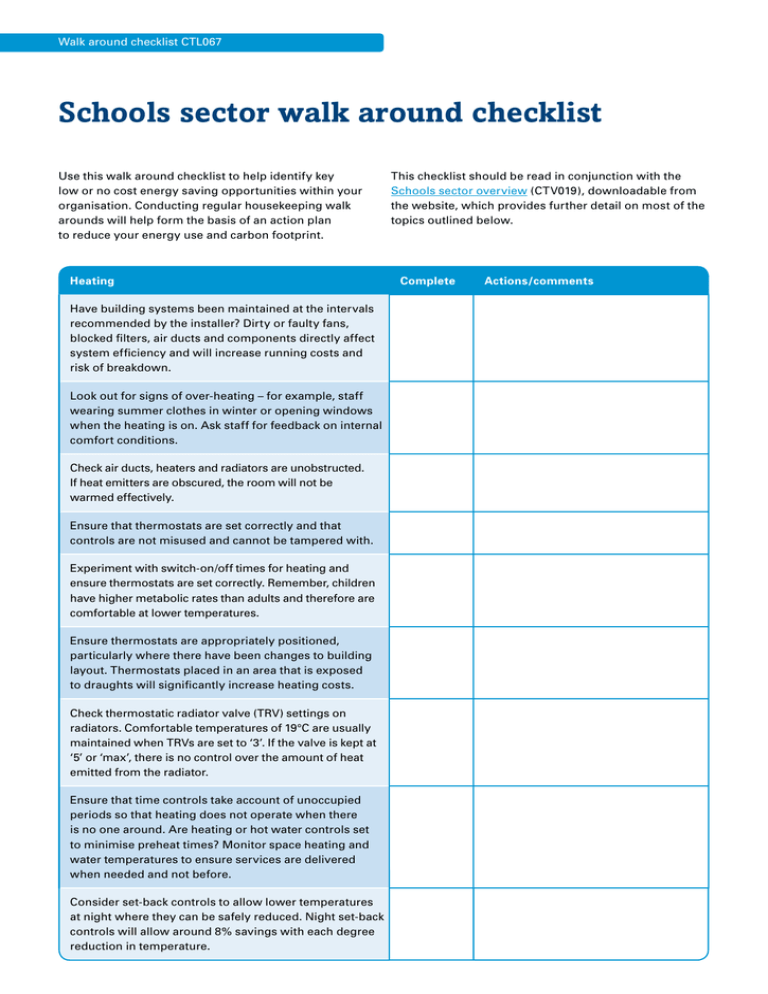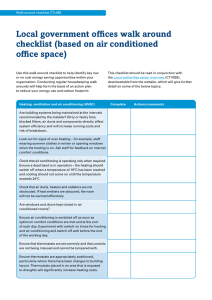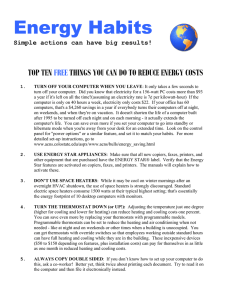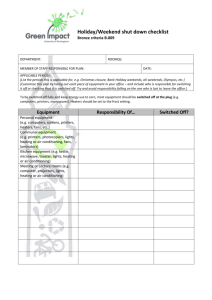
Walk around checklist CTL067
Checklist – CTL069
Schools sector walk around checklist
Use this walk around checklist to help identify key
low or no cost energy saving opportunities within your
organisation. Conducting regular housekeeping walk
arounds will help form the basis of an action plan
to reduce your energy use and carbon footprint.
Heating
Have building systems been maintained at the intervals
recommended by the installer? Dirty or faulty fans,
blocked filters, air ducts and components directly affect
system efficiency and will increase running costs and
risk of breakdown.
Look out for signs of over-heating – for example, staff
wearing summer clothes in winter or opening windows
when the heating is on. Ask staff for feedback on internal
comfort conditions.
Check air ducts, heaters and radiators are unobstructed.
If heat emitters are obscured, the room will not be
warmed effectively.
Ensure that thermostats are set correctly and that
controls are not misused and cannot be tampered with.
Experiment with switch-on/off times for heating and
ensure thermostats are set correctly. Remember, children
have higher metabolic rates than adults and therefore are
comfortable at lower temperatures.
Ensure thermostats are appropriately positioned,
particularly where there have been changes to building
layout. Thermostats placed in an area that is exposed
to draughts will significantly increase heating costs.
Check thermostatic radiator valve (TRV) settings on
radiators. Comfortable temperatures of 19°C are usually
maintained when TRVs are set to ‘3’. If the valve is kept at
‘5’ or ‘max’, there is no control over the amount of heat
emitted from the radiator.
Ensure that time controls take account of unoccupied
periods so that heating does not operate when there
is no one around. Are heating or hot water controls set
to minimise preheat times? Monitor space heating and
water temperatures to ensure services are delivered
when needed and not before.
Consider set-back controls to allow lower temperatures
at night where they can be safely reduced. Night set-back
controls will allow around 8% savings with each degree
reduction in temperature.
This checklist should be read in conjunction with the
Schools sector overview (CTV019), downloadable from
the website, which provides further detail on most of the
topics outlined below.
Complete
Actions/comments
Schools sector walk around checklist
Heating (continued)
Complete
Actions/comments
Complete
Actions/comments
Complete
Actions/comments
Where applicable check that controls such as weather
compensation, optimisation and seven day time control
are set correctly to save energy and money.
Ensure multiple boilers are interlinked so that both
boilers and circulation pumps are controlled by room
thermostats. This will ensure boilers do not fire when
there is no demand for heat.
Check insulation of boilers and associated pipework and
repair or replace if damaged.
Building fabric
Check whether parts of the building fabric are old or
damaged (e.g. in roofs or cavity walls) and repair if so.
Cold air and water may infiltrate which can cause
damage and lead to increased heating costs.
Check for draughts and damage to windows, window
frames and doors. Repair any damage and install or
maintain draught seals.
Lighting
Make optimum use of daylight in classrooms and turn
lights off where possible in order to reduce lighting
costs by 20%.
Check that lighting in unoccupied areas is switched off
as well as all non-essential lighting (including tubular
fluorescent lamps) outside core hours. Promotional
material, such as posters and stickers, will assist with
this task.
Check and label light switches to help staff and students
select only those lights they need for the work being
carried out.
Ensure external lighting is switched off during
the day.
Check sensors and timers on lights, making sure
they are altered when the clocks change.
Do you still use traditional tungsten light bulbs? If so
replace them with energy efficient, compact fluorescent
lamps (CFLs) to reduce operating and maintenance costs.
•Where appropriate, remove one fluorescent
tube from multiple tube fittings in corridors and
non-critical areas.
•Encourage staff to report failing lamps and replace
any failed lights with more efficient alternatives.
•If fittings are compatible, replace old-style 38 mm
(T12) fluorescent tubes with 26 mm (T8) tubes.
Schools sector walk around checklist
Lighting (continued)
Complete
Actions/comments
Complete
Actions/comments
Complete
Actions/comments
Complete
Actions/comments
Establish a basic lighting maintenance and cleaning
schedule to reduce costs as well as improving school
appearance. A cleaning schedule should include
windows, skylights, luminaires and sensors.
Catering
Are kitchen staff aware of the importance of being
energy efficient?
•Label equipment with minimum warm-up times.
•Use correctly sized equipment.
•Switch off unnecessary kitchen equipment and lights.
Ensure chiller doors are kept shut and that staff working
practice supports this.
IT and office equipment
Check and enable energy saving features on computers
and other electrical equipment.
Check hours of operation of all equipment and ensure all
unnecessary equipment is switched off overnight and at
weekends. The installation of timers can help automate
this process.
Miscellaneous facilities
Install seven-day timers on electrical equipment such
as kilns and fume cupboards. Make sure equipment is
switched off during holiday periods and enable standby
features on all equipment when it is being used
intermittently.
If applicable, is a swimming pool cover used whenever
the pool is not in use?
The Carbon Trust was set up by Government in 2001 as an
independent company.
The Carbon Trust’s mission is to accelerate the move to a low carbon
economy, by working with organisations to reduce carbon emissions
now and develop commercial low carbon technologies for the future.
We cut carbon emissions now
•By providing business and the public sector with expert advice,
finance and accreditation.
•By stimulating demand for low carbon products and services.
We cut future carbon emissions
•By developing new low carbon technologies through project funding
and management, investment and collaboration.
•By identifying market barriers and practical ways to overcome them.
www.carbontrust.co.uk
0800 085 2005
ACT ON CO 2 is the Government’s initiative to help
individuals understand and reduce their carbon footprint.
Visit http://actonco2.direct.gov.uk for more information.
The Carbon Trust is funded by the Department of Energy and Climate Change (DECC), the Department
for Business, Enterprise and Regulatory Reform (BERR), the Scottish Government, the Welsh Assembly
Government and Invest Northern Ireland.
Whilst reasonable steps have been taken to ensure that the information contained within this publication
is correct, the authors, the Carbon Trust, its agents, contractors and sub-contractors give no warranty
and make no representation as to its accuracy and accept no liability for any errors or omissions.
Any trademarks, service marks or logos used in this publication, and copyright in it, are the property
of the Carbon Trust. Nothing in this publication shall be construed as granting any licence or right to use
or reproduce any of the trademarks, service marks, logos, copyright or any proprietary information in
any way without the Carbon Trust’s prior written permission. The Carbon Trust enforces infringements
of its intellectual property rights to the full extent permitted by law.
The Carbon Trust is a company limited by guarantee and registered in England and Wales under Company
number 4190230 with its Registered Office at: 6th Floor, 5 New Street Square, London EC4A 3BF.
Published in the UK: March 2009.
© The Carbon Trust 2009. All rights reserved.
CTL067




